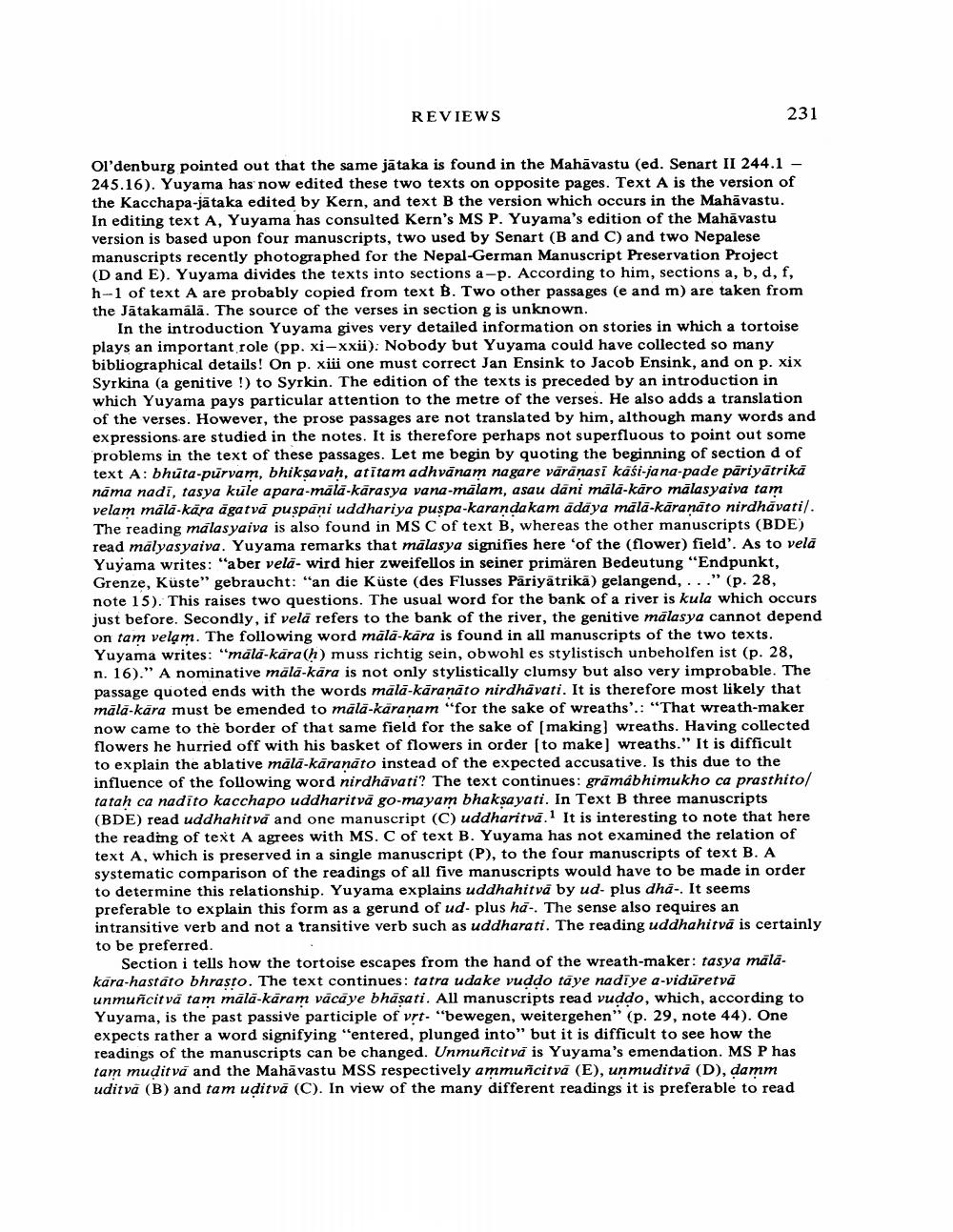________________
REVIEWS
231
Oldenburg pointed out that the same jätaka is found in the Mahävastu (ed. Senart II 244.1 - 245.16). Yuyama has now edited these two texts on opposite pages. Text A is the version of the Kacchapa-jätaka edited by Kern, and text B the version which occurs in the Mahāvastu. In editing text A, Yuyama has consulted Kern's MS P. Yuyama's edition of the Mahāvastu version is based upon four manuscripts, two used by Senart (B and C) and two Nepalese manuscripts recently photographed for the Nepal-German Manuscript Preservation Project (D and E). Yuyama divides the texts into sections a-p. According to him, sections a, b, d, f, h-1 of text A are probably copied from text B. Two other passages (e and m) are taken from the Jātakamálä. The source of the verses in section g is unknown
In the introduction Yuyama gives very detailed information on stories in which a tortoise plays an important role (pp. xi-xxii): Nobody but Yuyama could have collected so many bibliographical details! On p. xiii one must correct Jan Ensink to Jacob Ensink, and on p. xix Syrkina (a genitive !) to Syrkin. The edition of the texts is preceded by an introduction in which Yuyama pays particular attention to the metre of the verses. He also adds a translation of the verses. However, the prose passages are not translated by him, although many words and expressions are studied in the notes. It is therefore perhaps not superfluous to point out some problems in the text of these passages. Let me begin by quoting the beginning of section d of text A: bhūta-purvam, bhiksa vaḥ, atitam adhvānam nagare vārānasi kaśi-ja na-pade pāriyātrika nama nadi, tasya kule apara-mála-kārasya vana-malam, asau dāni mala-kāro malasyaiva tam velam mala-kära ägatvā puspani uddhariya puspa-karandakam ada ya mala-karanáto nirdhāvati/. The reading málasyaiva is also found in MS С of text B, whereas the other manuscripts (BDE) read malyasyaiva. Yuyama remarks that malasya signifies here 'of the (flower) field'. As to velā Yuyama writes: "aber vela- wird hier zweifellos in seiner primären Bedeutung "Endpunkt, Grenze, Küste" gebraucht: "an die Küste (des Flusses Pariyātrikā) gelangend, ..." (p. 28, note 15). This raises two questions. The usual word for the bank of a river is kula which occurs just before. Secondly, if vela refers to the bank of the river, the genitive mālasya cannot depend on tam velam. The following word mála-kāra is found in all manuscripts of the two texts. Yuyama writes: "mála-kara(h) muss richtig sein, obwohl es stylistisch unbeholfen ist (p. 28, n. 16)." A nominative mälä-kära is not only stylistically clumsy but also very improbable. The passage quoted ends with the words malā-kāranāto nirdhavati. It is therefore most likely that māla kāra must be emended to māla-karanam "for the sake of wreaths'.: "That wreath-maker now came to the border of that same field for the sake of (making) wreaths. Having collected flowers he hurried off with his basket of flowers in order to make) wreaths." It is difficult to explain the ablative mala-karanáto instead of the expected accusative. Is this due to the influence of the following word nirdhāvati? The text continues: grāmabhimukho ca prasthito/ tatah ca nadito kacchapo uddharitvā go-mayam bhaksayati. In Text B three manuscripts (BDE) read uddhahit va and one manuscript (C) uddharitva.' It is interesting to note that here the reading of text A agrees with MS. C of text B. Yuyama has not examined the relation of text A, which is preserved in a single manuscript (P), to the four manuscripts of text B. A systematic comparison of the readings of all five manuscripts would have to be made in order to determine this relationship. Yuyama explains uddhahitvá by ud- plus dha-. It seems preferable to explain this form as a gerund of ud. plus ha-. The sense also requires an intransitive verb and not a transitive verb such as uddharati. The reading uddhahitva is certainly to be preferred.
Section i tells how the tortoise escapes from the hand of the wreath-maker: tasya malā. kara-hastáto bhrasto. The text continues: tatra udake vuddo taye nadiye a-vidüretva unmuñcit vä tam mala-käram vāca ye bhāsati. All manuscripts read vuddo, which, according to Yuyama, is the past passive participle of vrt. "bewegen, weitergehen" (p. 29, note 44). One expects rather a word signifying "entered, plunged into" but it is difficult to see how the readings of the manuscripts can be changed. Unmuncit va is Yuyama's emendation. MS P has tam mudit va and the Mahāvastu MSS respectively ammuncitvā (E), unmuditva (D), damm uditvà (B) and tam uditvā (C). In view of the many different readings it is preferable to read




